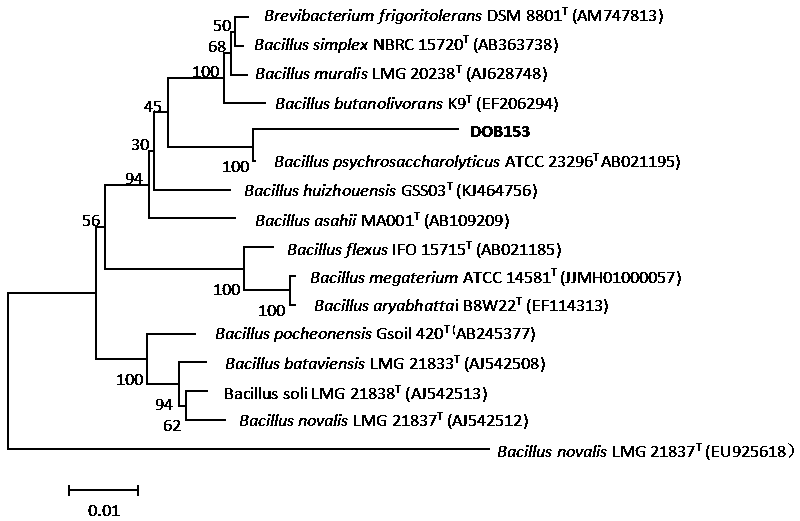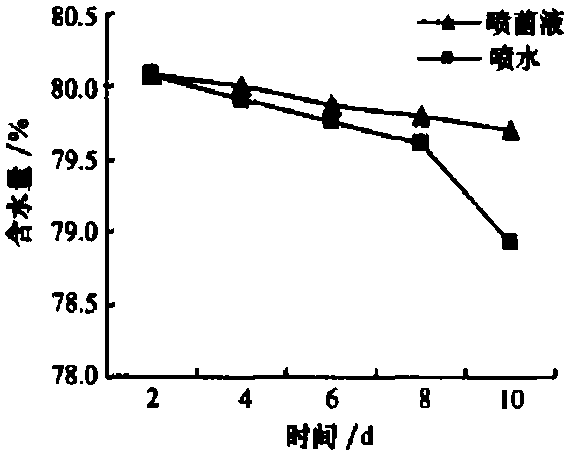A desert oligotrophic bacterium dob153 and its application in sand fixation
An oligotrophic, desert-based technology, applied to the application of new oligotrophic bacteria in biological crusts to fix quicksand, in the field of microbial applications, can solve the problems of rare reports of oligotrophic microorganisms and the application of oligotrophic bacteria, and achieve growth rates Fast, strong growth and reproductive ability, and stable genetic characteristics
- Summary
- Abstract
- Description
- Claims
- Application Information
AI Technical Summary
Problems solved by technology
Method used
Image
Examples
Embodiment 1
[0020] Example 1: Isolation, screening and identification of oligotrophic bacteria Bacillus sp.DOB153CGMCC NO.11926
[0021] 1. Isolation and screening of strains
[0022] The desert oligotrophic bacteria used in the present invention are sampled and isolated from the Gurbantunggut Desert in Junggar Basin, Xinjiang, and the strains capable of growing on LB medium are preliminarily screened out according to the analysis of the action mechanism of the bacteria. The microorganisms in the Gurbantunggut Desert in the Junggar Basin of Xinjiang were isolated by the traditional plate culture method, the strains were screened by primary screening and secondary screening, and the strains were purified by plate streaking method, and the bacterial strains were compared on the LB medium. According to the growth and reproduction situation, a batch of well-growing microbial strains were screened out, and a desert oligotrophic bacterial strain numbered DOB 153 with good comprehensive performa...
Embodiment 2
[0036] Example 2: Molecular identification of oligotrophic bacteria Bacillus sp.DOB153CGMCC NO.11926
[0037] 1. PCR amplified DNA sequence of oligotrophic bacteria DOB153 and its sequencing
[0038] Pick a small amount of single colony of oligotrophic bacteria DOB153 strain, put it into an EP tube filled with 25 μL of sterile water, boil it at 100°C for 8-10 minutes, then quickly put it into the ice-water mixture for 5 minutes, centrifuge at 10000r / min, 5min, 4 Store at ℃, take the supernatant when used.
[0039] 16S rDNA gene sequence determination and phylogenetic tree construction: Extract the total DNA of oligotrophic bacteria DOB153 strain according to conventional methods, and use deionized water to dilute the universal primers for PCR amplification of 16S rDNA segments.
[0040] The 50 μl reaction system contained: 5 μl of 10×PCR buffer, 20 pmol of each primer, 1 μl of template DNA, 0.5 U of TaqTM (TaKaRa Company), and 8 μl of dNTP. PCR amplification conditions: pre-...
Embodiment 3
[0045] Example 3: Research on the characteristics of oligotrophic bacteria Bacillus sp.DOB153CGMCC NO.11926
[0046] 1. Experimental process
[0047] The oligotrophic bacterium DOB153 was repeatedly streaked and activated on LB medium, and then used for the preparation of liquid bacterial agent. After inoculation, it was cultured in a shake flask at 37°C for 60 hours.
[0048] (1) Sand fixation test
[0049] Use quicksand to pack 2 disks with a length of 30cm × width 20cm × height 5cm, put the quicksand into the tray, and spray the oligotrophic bacteria DOB153 on the quicksand surface of one of the sand trays, and the other sand tray. An equal amount of tap water served as a control.
[0050] (2) Water retention test
[0051] Take 20 crucibles with known drying constant weight (wherein 10 are sprayed with water for comparison, and 10 are sprayed with bacterium solution of oligotrophic bacteria DOB153) and weighed, denoted as W 1 , respectively weighing 30g of sand into the...
PUM
 Login to View More
Login to View More Abstract
Description
Claims
Application Information
 Login to View More
Login to View More - R&D
- Intellectual Property
- Life Sciences
- Materials
- Tech Scout
- Unparalleled Data Quality
- Higher Quality Content
- 60% Fewer Hallucinations
Browse by: Latest US Patents, China's latest patents, Technical Efficacy Thesaurus, Application Domain, Technology Topic, Popular Technical Reports.
© 2025 PatSnap. All rights reserved.Legal|Privacy policy|Modern Slavery Act Transparency Statement|Sitemap|About US| Contact US: help@patsnap.com



